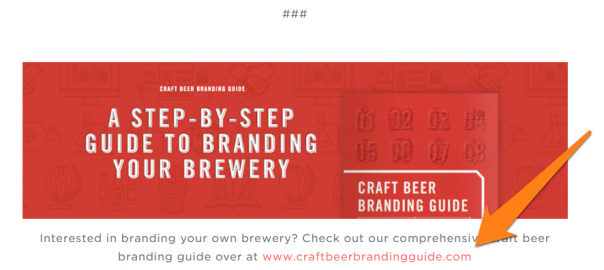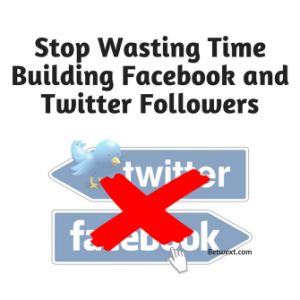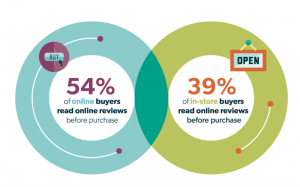— November 28, 2017
Leads are the foundation of any successful sales process. The quality and quantity of your leads determine the quality and quantity of your clients.
Any agency that wants to scale its operations should first focus on scaling its lead-generation. A well-defined, systematic process for capturing, qualifying and converting leads can help you grow much faster.
More importantly, a lead-generation system brings much-needed stability to the often unpredictable agency business.
In this guide, I’ll show you how you can build a lead-generation system from scratch. You’ll learn how to capture leads, how to qualify them, and how to scale operations using cutting-edge processes.
The Case for Using a Lead-Generation System
Despite the low startup costs, the agency business can be surprisingly risky.
Much of this risk stems from the failure of agencies to build a steady stream of prospects. Most agencies rely on a combination of referrals, events and cold outreach to get leads and new clients.
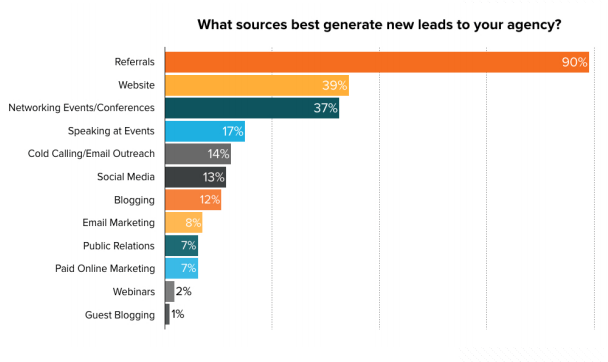
While effective, this is neither stable nor scalable. Your leads might scale up or dry out based on your efforts or prevalent market condition.
In contrast, a lead-generation system brings in a predictable number and quality of leads every month.
Suppose you rank on the first spot for a keyword that gets 3,000 searches/month. With such rankings, you can reasonably expect to get 1,000 visitors/month.
Of these 1,000 visitors, you can convert at least 1-3% into leads. That gets you 10-30 leads each month, every month.
To scale things up, you only need to rank for more such keywords.
Further, this entire operation can run completely on autopilot. You don’t have to have people actually cold-calling or attending events.
This predictability is the reason why more and more marketers are moving towards scalable sources of traffic and leads such as SEO, content, social media, etc.
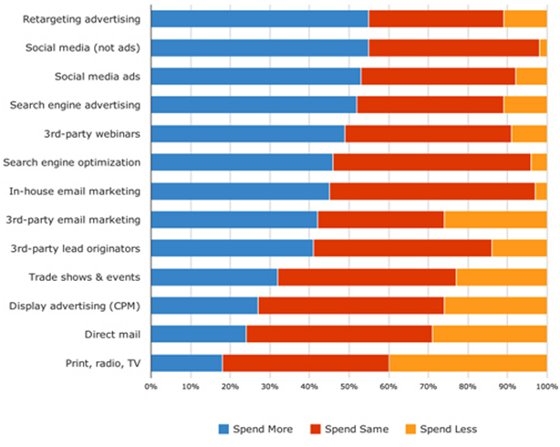
In the next section, I’ll dig into the lead-generation process in more detail.
Understand the Lead-Generation System
A typical B2B sales process can be broken down into four broad steps:
- Lead Generation where you capture leads.
- Lead Qualification where you determine whether a lead is qualified or not. Unqualified leads are either discarded or nurtured further.
- Lead Nurturing where qualified leads are nurtured until they are ready to buy.
- Lead Conversion where leads either buy or are passed onto sales as an opportunity.
Think of it as a machine. You feed it targeted traffic. It filters out unqualified leads, nurtures qualified ones and you end up with an MQL or Marketing Qualified Lead after which, sales takes over.
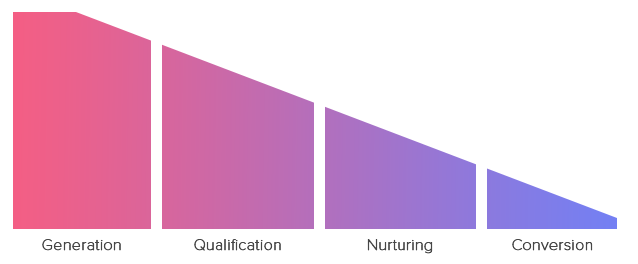
You don’t have to concern yourself with all these marketing terms such as ‘MQL’ and ‘opportunity’ – at least not yet.
For now, your focus should be the first stage of the process – Lead Generation.
To generate leads, you essentially need four things:
- A thorough understanding of what your target audience wants and where it hangs out.
- An offer that is relevant to your target audience.
- A way to capture data in exchange for the offer.
- Targeted traffic to send to this offer.
There might be several variations and intermediary steps, but the overall process remains largely the same.
I’ll walk you through the first stage in this process – understanding your audience – in the next section.
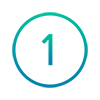
Customer Research
Regardless of what tactic you use to generate leads, your first step in the lead-gen process should always be customer research.
You might already have broad buyer personas for your primary marketing campaign.
For lead-gen, however, you want to drill down further and define a highly specific segment for that particular campaign. Everything that follows – landing page design, traffic strategy, even form length – will spring from this research.
To do this, first figure out the “Four W’s” for your customers:
- Who your customers are (i.e. age, occupation, location, and other demographic data).
- What these customers want (“improved workflow”, “more integrations with existing software”, etc.).
- Where these customers can be found online (LinkedIn, Reddit, etc.).
- Why your product/service would help them.
Try to be as specific as possible. Each metric you identify can be the springboard for another segment (and lead-gen campaign).
For example, suppose you’re running a lead-gen campaign to attract interest from small craft beer brands.
In this case, you might have the following data:
- Founders who live in Georgia and are aged between 35-50 (Who).
- Improved brand design and a cohesive brand identity (What).
- /R/Brewers subreddit and industry-focused blogs (Where).
- Showcase prior work with craft-brewers and brands targeting the same market (Why).
You can drill down further for an even more targeted campaign. For instance, instead of targeting all of Georgia, you could just target small brewers based out of Atlanta.
This way, you can create multiple campaigns from a single dataset.
Unfortunately, there is no one-source-fits-all solution to finding this customer data. You’ll have to rely on a mix of subjective and objective data collected through industry research, surveys, customer interviews, and tools such as Facebook audience research.
Once you have this data, jump to the next step – creating offers.
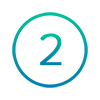
Create Offers
An offer is exactly that – what you offer to a customer in exchange for data.
This offer can be anything – a downloadable eBook, a tool, a webinar, and so on.
The two keywords you should focus on are value and interest. Whatever offer you create must have enough perceived value to be attractive to prospective clients.
At the same time, it must align with their interests. Visitors should be able to extract positive takeaways from the offer.
The customer data you uncovered in step #1 will be tremendously useful here. The ‘What’ you identified above should be the foundation of your offer.
For instance, if the ‘What’ is “cohesive brand identity”, you could create an eBook on brand identity as your offer.
There are a few things you need to consider when creating your offer:
1. Choose the Right Content Format for the Buyer’s Journey Stage
The buyer’s journey is a hypothetical path or journey your customers undertake before buying from you. Through its three stages – Awareness, Consideration, and Decision – buyers go from being ignorant about your product to purchasing it.
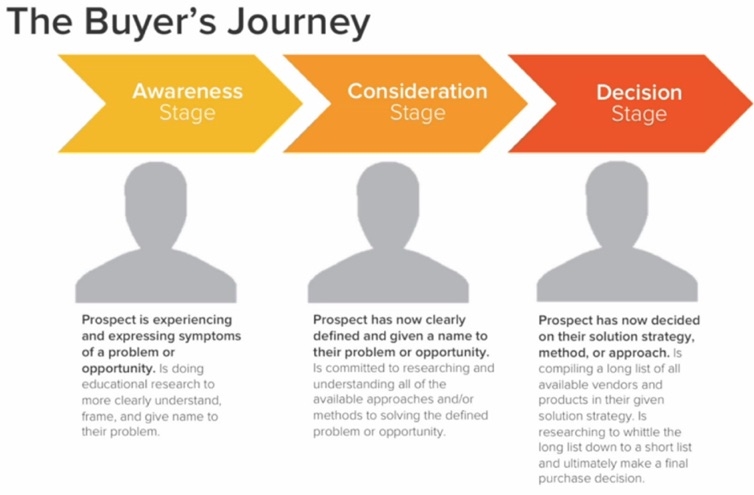
Not every content format works for every stage of the buyer’s journey. A customer just discovering your service (i.e. the Awareness stage) wouldn’t want to invest an hour of his time in a webinar.
Therefore, in your lead-generation campaign, figure out:
- The stage of the buyer’s journey the target audience belongs to
- The most appropriate content format for that stage
Broad campaigns typically target Awareness stage customers. If you’re targeting a very narrow band of customers (“founders of craft brewing companies in California with under $ 5M in revenue”), your campaign will fall in the Consideration or Decision stages.
These customers already know a bit about their problems and need more education before purchasing.
Use the following chart to figure out what content format to choose based on the buyer’s journey stage:
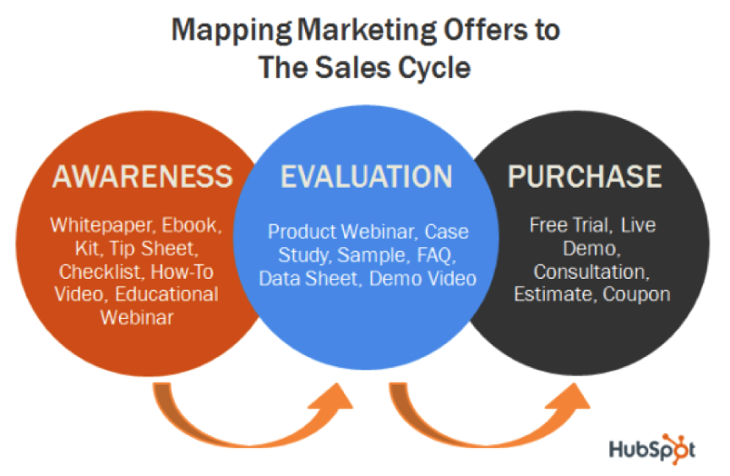
As customers move along the buyer’s journey, they’re willing to invest in more demanding content formats.
Take this into account before creating a content offer.
2. Address Client Concerns in the Offer
Why should a client invest in reading a 10-page whitepaper from your agency?
“Because it offers them value” isn’t a good enough reason, especially when there are dozens of other agencies doing the same.
What you need to focus on are:
- How your offer applies to their specific situation
- Why you’re the right agency to solve their problems
Which is to say, you need to hyper-target your content offer to your audience cohort. Then you need to win their trust through testimonials, case studies and other social proof from similar clients.
For example, this offer from MuleSoft identifies its target audience in the title itself – SaaS providers who want to scale to enterprise customers.
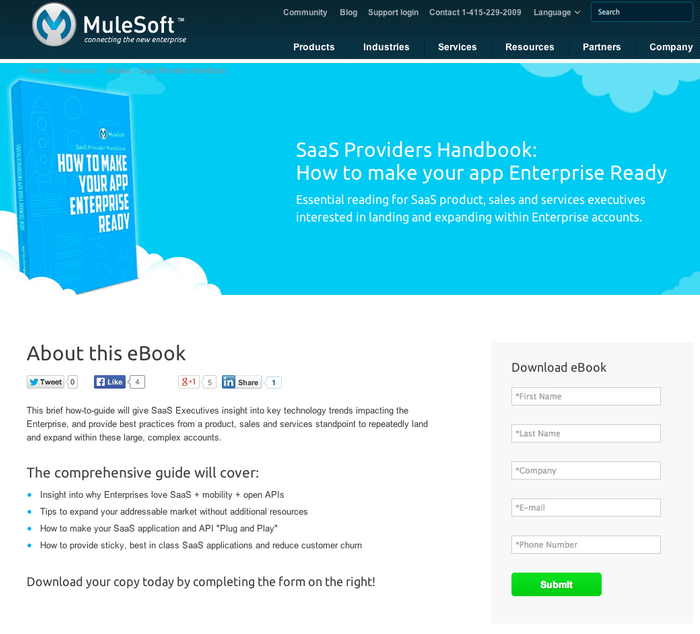
Similarly, this lead magnet from SyncShow has a narrow audience: manufacturers who want to use inbound methodologies.
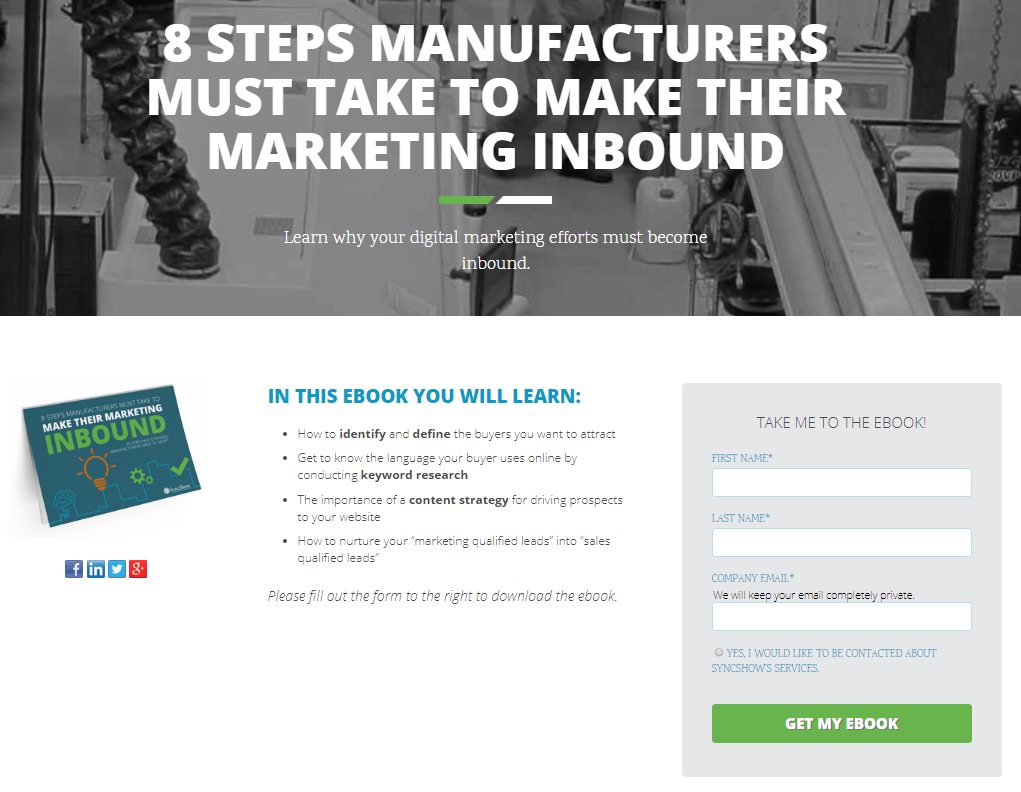
Identifying the target audience clearly addresses a key customer concern: “what’s in it for me?”
Follow that up with social proof on the landing page and you’ll see your conversion rates skyrocket.
In the next section, I’ll discuss the most important element in a lead-gen campaign: the lead-capture form.
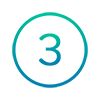
Create a High-Converting Landing Page
A landing page is what separates a visitor from a lead. Any traffic that manages to go past the form on the landing page is essentially a lead.
For this reason, optimizing your landing pages should be a high-priority. A marginal improvement in landing page conversion rates can lead to significant changes in your lead-gen campaign success rate.
I’ll illustrate with an example.
Suppose you improve your landing page conversion rate from 1% to 1.2%. A 0.2% improvement might not sound worth pursuing, but for every 10,000 visitors, it essentially means an extra 20 leads.
Over a year, this is 240 extra leads. At a 1% conversion rate, this is 2 extra clients. At $ 3,000/month retainers, this is $ 72,000 in extra revenue.

All from a tiny 0.2% improvement in conversion rate for a landing page.
So how do you improve landing page conversion rates?
Three ways:
- Improve the offer
- Improve the design and copy
- Improve the form
I’ve already covered #1 earlier, so in the next section, I’ll focus on design, copy and the form.
1. Landing Page Design and Copy
The design and copy of a landing page have a marked impact on its conversion rate. Minor changes such as changing a button color can improve CTR by 21%, as in this case study.
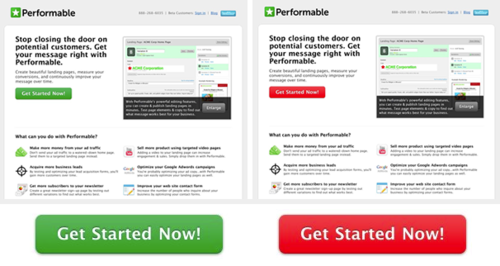
While there is no “perfect” design/copy that works for every campaign, the following structure works well in most cases:
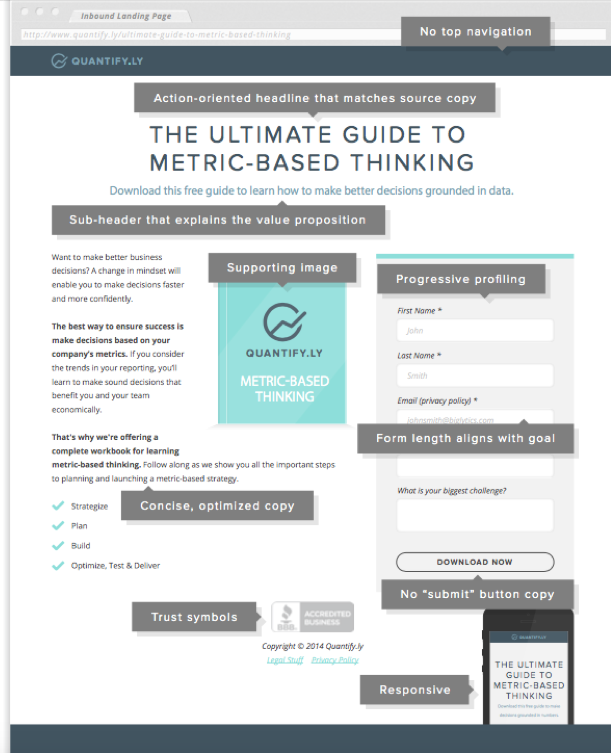
With this layout, you’re essentially:
- Highlighting the key value proposition in the headline.
- Expanding on the value proposition in a couple of paragraphs.
- Highlighting the key takeaways via bullet points.
- Showcasing the offer via a product image.
For example, this landing page by InboundEmotion follows a similar layout:
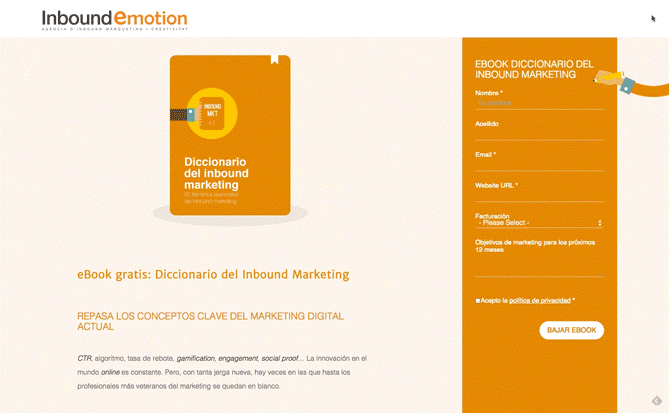
While your layout should focus on clarity and value, the copy itself should emphasize two things:
- The benefits and the features of the offer. If you must focus on only one, focus on the benefits.
- Social proof that emphasizes the value of the offer and your expertise.
- Authority in the form of social proof, industry recognition & rankings, experience and past results.
You don’t have to create a landing page to capture lead information, of course. You can also use pop-ups with a single field for an email address.
Unfortunately, landing page design is a broad topic that’s beyond the scope of this article. Unbounce’s landing page 101 course is a good place to start on this topic. For inspiration, check out the landing pages on this site.
2. Create Conversion-Focused Forms
The form is where the magic happens.
This is where visitors go from “traffic” to “leads”.
The better the form design, the better your conversion rates.
While the aesthetic of the form is certainly important, what’s critical is aligning the form with the landing page demands and the audience’s comfort-level. A good form asks for just enough information to fit your and your audience’s requirements.
You might be tempted to add extra fields so you have richer customer data. Resist. Longer forms almost always reduce conversion rates.
In one study, cutting down the number of form fields from 9 to 5 improved fill-rates by 34%. In another study, replacing an 11-field form with a 4-field form improved conversion rates by 120%.
While you’re doing that, ensure that your form uses a single-column layout. Eye-tracking studies show that users have difficulty comprehending information-flow in multi-column layouts.
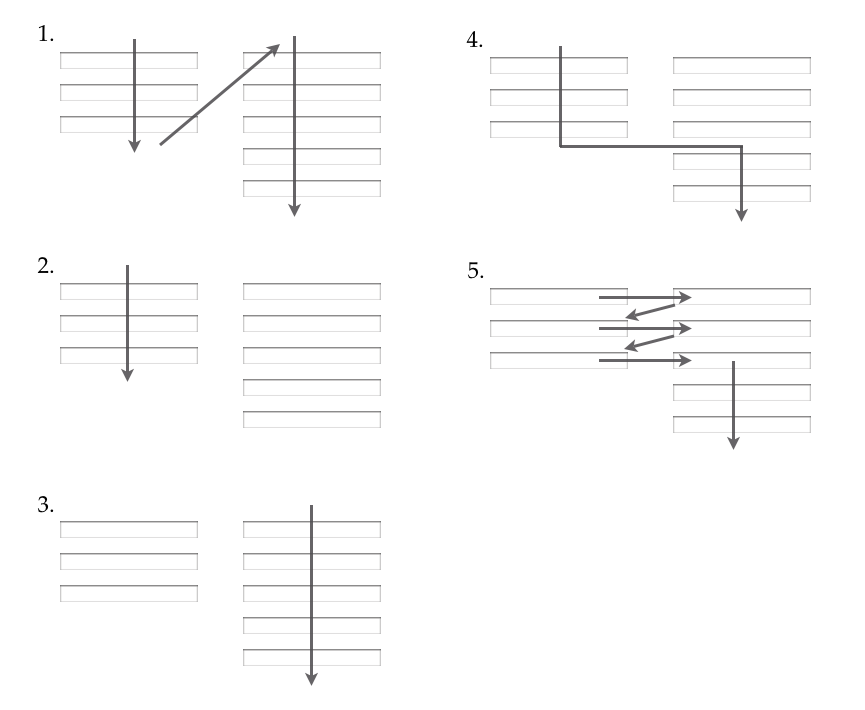
If you must use a longer form to capture more data, consider creating a multi-step form. Alternatively, use a progressive lead-qualification process where you ask for more and more information as the lead progresses down the funnel.
This means asking for the most basic information in the first download and gradually expanding to ask for more data as the lead consumes more content.
Ensure that your form itself is easy to follow. Offer clear directions and make it easy for users to fill up the form.
Finally, use a large, legible button on the form. Use action words (“Submit”, “Click”, “Go”, etc.) and tell people what will happen once they click the button (“Click Here to Download Your Book”).
Make this button easy to spot on the page by using contrasting colors. In one case study, changing button color from blue to a brighter green improved conversion rate by nearly 36%.
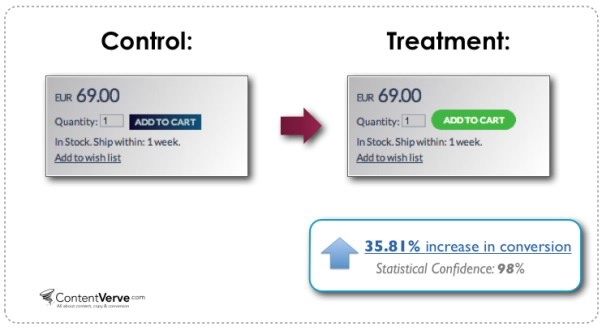
In the next section, I’ll share insight on the final ingredient in the lead-gen system: quality traffic.
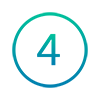
Attract Targeted Traffic
With the offer, landing page and form, you have all the basic elements of a lead-generation system in place.
The only thing you need now is to send targeted traffic to this system.
This might be the easiest (or hardest) part of the process depending on your budget and expertise.
Below, I’ll share some tactics for attracting targeted traffic to your offers.
1. Create Content Focused on Your Audience
How do you attract highly-targeted traffic to your offers?
Simple: you create content that would attract the people your offer is targeted towards. You then distribute this content through media outlets, social sharing sites, and niche communities.
A great example of this is CODO’s attempt to reach out to craft brewery brands. On its blog, it has an in-depth article about branding trends in the craft beer industry in 2017.
At the bottom of this blog post, readers can either read a more in-depth guide to craft beer branding…
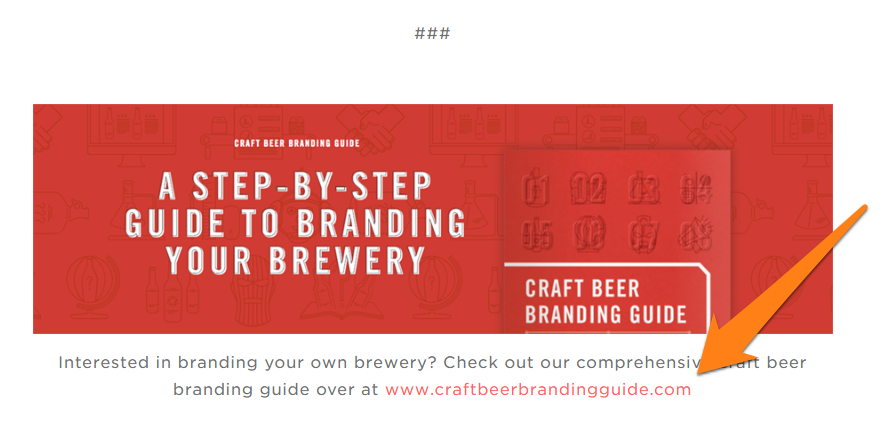
…or they can immediately contact one of CODO’s account managers and learn more about their services.
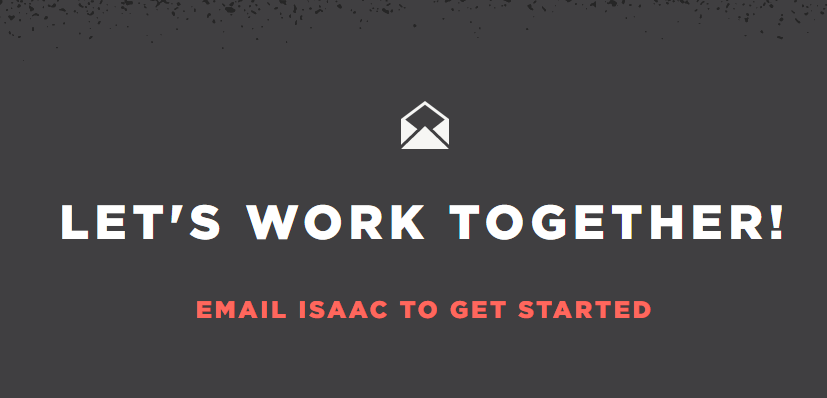
This works because:
- The content gives significant value to the readers while also introducing them to ideas about craft beer branding.
- The craft beer branding guide acts as an optional “content upgrade” for people who are on the fence about CODO’s services and need more convincing.
- The CTA at the bottom of the post gives interested parties an easy way to reach out to CODO.
Such hyper-targeted content is a great way to pitch your offer and attract quality traffic.
2. Rank for a Single Keyword Related to Your Offer
Ranking for a relevant keyword will attract targeted traffic to your offer for months, even years to come.
What keyword(s) you choose to target will depend on:
- The topic of your offer. Ideally, the keyword should have some relevance to the offer.
- The keyword’s relevance to your business (which should be taken care of if you followed #1 above).
- The keyword’s difficulty in terms of SEO competition.
- Your own SEO capabilities.
I recommend focusing on a single keyword instead of spreading out your SEO-efforts over multiple keywords.
For example, UIBreakfast ranks for the keyword “improve SaaS UI” with its free course. At the bottom of this page is an opt-in form to get access to the course.
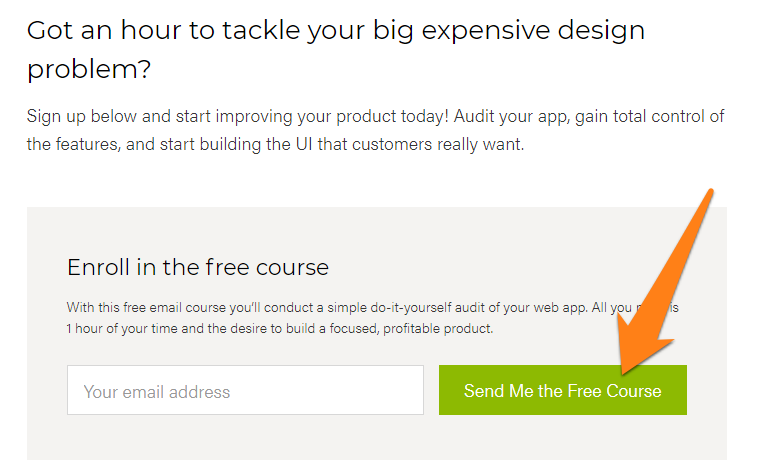
This gives UIBreakfast a lead through organic traffic.
3. Buy Traffic
If you have a large ad budget, you can simply buy spots on Google and acquire laser-targeted traffic.
For example, NativeCommerce bids on keywords such as “content marketing agency” and asks visitors to fill in their information for a free consultation call:
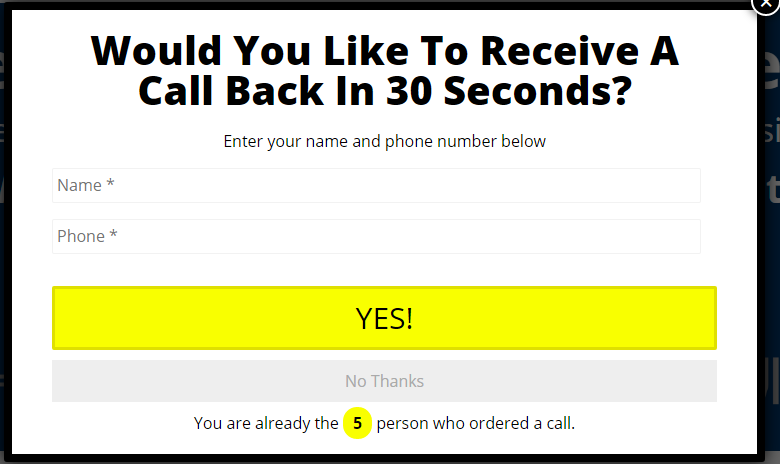
This is the easiest way to get targeted traffic, but also the most expensive.
At the same time, buying traffic can yield very quick insight into the relevance of your offer. I recommend buying some traffic to determine the offer relevance and conversion rate before investing in a large-scale SEO or content campaign.
There are a number of other ways to attract targeted traffic to your offers, but for most agencies, the above tactics will suffice. Use this as a springboard for your marketing campaign.
Conclusion
A well-defined lead-generation system is often the difference between a fledgling and a failing agency. If you can attract a stable number of leads every month, it becomes much easier to scale your agency business while also mitigating risk.
Business & Finance Articles on Business 2 Community
(64)
Report Post